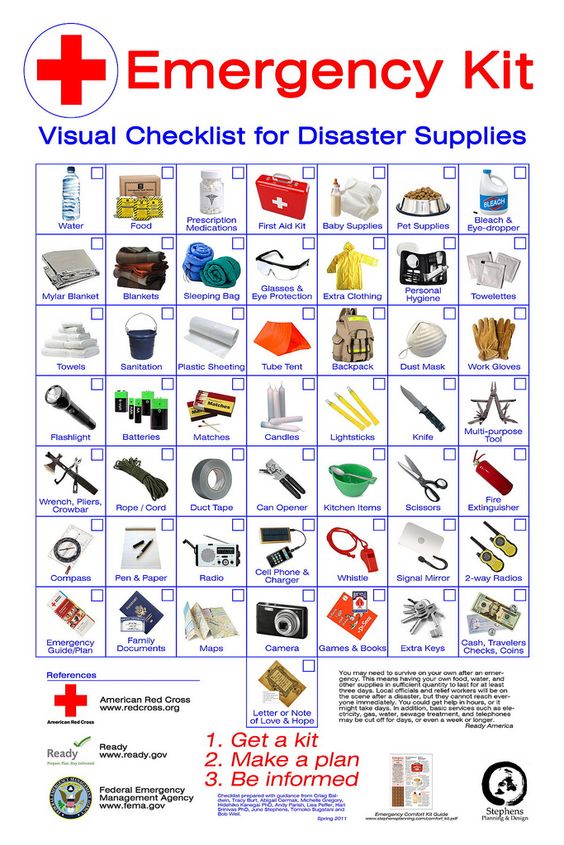EMERGENCY PREPAREDNESS – WATER
Now that you have a place to store your supplies (see Part 1 – Emergency Preparedness – Storage) You will need to address the subject of food and water. In this post, I’m only going to address WATER.
If disaster strikes your community, you might lose access to clean water. You should begin with a 3 day (72 hours) supply.
We were without electricity for 8 days once due to a snow storm so 3 days is a minimum but I would at least have a minimum of one week’s supply of water.
WATER
Water is the most important thing to store and should be first on your list. You can not survive without clean drinking water!
STEP 1: DECIDE HOW MUCH WATER YOUR FAMILY WILL NEED
- According to the CDC, you need at least 1 gallon of water per person per day for 3 days. A normally active person needs to drink at least one-half gallon of water each day. You will also need water to clean yourself and to cook. (This means a family of four needs 12 gallons of water in their emergency supply.) The 3 day suggested supply is only a start, as you build your emergency stockpile, you will want to add more.
- Don’t forget about pets!
- Cats and dogs typically need 1 gallon for 3 days.
STEP 2: GATHER AND STORE YOUR EMERGENCY WATER SUPPLY

There are several options for storing clean water:
- Buy pre-packaged bottled water (the safest, most reliable option).
- Do not open the containers until you’re ready to use them.
- Check expiration dates on store-bought bottled water throughout the year. Replace as needed.
- Fill your own containers of water.
- Use food-grade water storage containers, like those found at surplus or camping supply stores. If you cannot buy this type of container, you can use 2-liter plastic soda bottles.
- Purchase a bathtub storage system. If you are not sure what I am talking about, google “bathtub water storage” and you will see several options and price ranges. You can purchase one for as low as $20 which is cheap for something so important.
If you do not have access to clean water, you will need some way to purify your water. Here are a few of your options:
Boiling
If you don’t have safe bottled water, you should boil your water to make it safe to drink. Boiling is the best method to kill disease-causing organisms, including viruses, bacteria, and parasites. It will not remove chemical toxins, heavy metals, or salts. If possible, get water from a moving source such as a river, creek, or stream.
If the water is cloudy,
- Filter it through a clean cloth, paper towel, or coffee filter OR allow it to settle.
- Draw off the clear water.
- Bring the clear water to a rolling boil for one minute (at elevations above 6,500 feet, boil for three minutes).
- Let the boiled water cool.
- Store the boiled water in clean sanitized containers with tight covers.
If the water is clear,
- Bring the clear water to a rolling boil for one minute (at elevations above 6,500 feet, boil for three minutes).
- Let the boiled water cool.
- Store the boiled water in clean sanitized containers with tight covers.
Purification of Water by Chlorination 
You can purify water using liquid chlorine bleach to kill microorganisms and other harmful pathogens as well as preventing the spread of waterborne diseases. This method is called chlorination.
Add 2 drops of bleach per quart of water (four drops if the water is cloudy), stir or shake and let the water stand for at least 30 minutes.
If it doesn’t have a slight chlorine smell, add another drop or two, shake or stir, and let it stand another 15 minutes.
Be sure to avoid using bleach with perfumes or dyes added. Bleach will not remove chemical pollutants and does not kill all disease causing organisms.
Using Water Purification
Tablets Purification tablets release iodine or chlorine to purify water. They are relatively inexpensive and readily available online as well as at most sporting goods stores and even some drugstores. Each package comes with directions to follow. Usually, one tablet is good for each quart of water. If the water is cloudy, you might be able to double the dose. Water is safe to drink in approximately 30 minutes. These tablets are used for short-term and emergency uses only, and should not be relied upon for constant water purification. While purification tablets protect against most pathogens (like giardia), they also neutralize the iodine aftertaste and color, helping your drinking water taste better.
Filters
Many portable water filters can remove disease-causing parasites such as Cryptosporidium and Giardia from drinking water. If you are choosing a portable water filter, try to pick one that has a filter pore size small enough to remove parasites. Most portable water filters do not remove bacteria or viruses.
Carefully read and follow the manufacturer’s instructions for the water filter you intend to use. After filtering, add a disinfectant such as iodine, chlorine, or chlorine dioxide to the filtered water to kill any viruses and remaining bacteria.
For more information about water filters that can remove parasites, see the CDC’s A Guide to Water Filters.


















